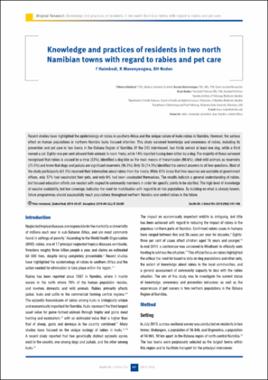| dc.contributor.author | Haimbodi, F. | |
| dc.contributor.author | Mavenyengwa, R. | |
| dc.contributor.author | Noden, B. H. | |
| dc.date.accessioned | 2022-04-12T13:54:13Z | |
| dc.date.available | 2022-04-12T13:54:13Z | |
| dc.date.issued | 2014 | |
| dc.identifier | oksd_noden_knowledgeandpractices_2014 | |
| dc.identifier.citation | Haimbodi, F., Mavenyengwa, R., & Noden, B. H. (2014). Knowledge and practices of residents in two north Namibian towns with regard to rabies and pet care. Southern African Journal of Infectious Diseases, 29(4), pp. 141-146. https://doi.org/10.1080/23120053.2014.11441589 | |
| dc.identifier.uri | https://hdl.handle.net/11244/335193 | |
| dc.description.abstract | Recent studies have highlighted the epidemiology of rabies in southern Africa and the unique nature of kudu rabies in Namibia. However, the serious effect on human populations in northern Namibia lacks focused attention. This study surveyed knowledge and awareness of rabies, including its prevention and pet care in two towns in the Oshana Region of Namibia. Of the 245 interviewed, two thirds owned at least one dog, while a third owned a cat. Eighty-one per cent allowed their animals to roam freely, while 14% reported having been bitten by a dog. The majority of those surveyed recognised that rabies is caused by a virus (53%), identified a dog bite as the main means of transmission (90.6%), cited wild animals as reservoirs (75.5%) and knew that dogs and jackals are significant reservoirs (96.3%). Only 35 (14.3%) identified the correct answers to all four questions. Most of the study participants (63.3%) received their information about rabies from the media. While 83% knew that free vaccines are available at government offices, only 37% had vaccinated their pets, and only 6% had been vaccinated themselves. The results indicate a general understanding of rabies, but focused education efforts are needed with respect to community members in order for specific points to be clarified. The high level of knowledge of vaccine availability, but low coverage, indicates the need for mobilisation with regard to at-risk populations. By building on what is already known, future programmes should successfully reach populations throughout northern Namibia and control rabies in the future. | |
| dc.format | application/pdf | |
| dc.language | en_US | |
| dc.publisher | Informa UK Limited | |
| dc.relation.ispartof | Southern African Journal of Infectious Diseases, 29 (4) | |
| dc.rights | This material has been previously published. In the Oklahoma State University Library's institutional repository this version is made available through the open access principles and the terms of agreement/consent between the author(s) and the publisher. The permission policy on the use, reproduction or distribution of the material falls under fair use for educational, scholarship, and research purposes. Contact Digital Resources and Discovery Services at lib-dls@okstate.edu or 405-744-9161 for further information. | |
| dc.subject.mesh | rabies | |
| dc.subject.mesh | knowledge | |
| dc.subject.mesh | prevention | |
| dc.subject.mesh | dogs | |
| dc.subject.mesh | Namibia | |
| dc.subject.mesh | southern Africa | |
| dc.title | Knowledge and practices of residents in two north Namibian towns with regard to rabies and pet care | |
| dc.date.updated | 2022-04-07T14:31:55Z | |
| osu.filename | oksd_noden_knowledgeandpractices_2014.pdf | |
| dc.description.peerreview | Peer reviewed | |
| dc.identifier.doi | 10.1080/23120053.2014.11441589 | |
| dc.description.department | Entomology and Plant Pathology | |
| dc.type.genre | Article | |
| dc.type.material | Text | |
| dc.subject.keywords | Vaccine Related | |
| dc.subject.keywords | Rare Diseases | |
| dc.subject.keywords | Prevention | |
| dc.subject.keywords | 3 Good Health and Well Being | |
| dc.identifier.author | ORCID: 0000-0002-0096-370X (Noden, BH) | |
| dc.identifier.author | ScopusID: 6601968347 (Noden, BH) | |
